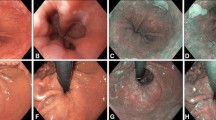Abstract
We have reviewed articles on the longitudinal vessels observed in the lower esophagus. In our previous study, we observed longitudinal (palisading) vessels through the mucosal epithelium in 884 (98%) of 905 consecutive endoscopic examinations of the lower esophagus, whereas in 20 examinations (2%) they could not be observed because of inflammation. The lengths of the longitudinal vessels were within the range of 2 to 3 cm in 90% of investigations. “Indentation” (notch or narrowing) compatible with the esophageal hiatus was observed in the transitional zone between the tubal esophagus and saccular stomach by both radiographic (as an indentation) and endoscopic (as a narrowing; we used the term indentation in this article) examinations. In cases without hiatal hernia, the indentation coincided with the esophagogastric junction (EGJ). We examined endoscopically the relationships among the locations of the indentation, squamocolumnar junction, and the longitudinal vessels. In no patients did we observe longitudinal vessels through the gastric mucosa beyond the indentation. Therefore, observation of longitudinal vessels through the mucosal epithelium was an indicator that the mucosa was located within the esophagus. However, in 21% of the 884 observations, columnar-lined mucosa was seen continuously from the gastric mucosa proximally beyond the indentation, and longitudinal vessels were observed through this columnar-lined mucosa. Because the longitudinal vessels were peculiar to the esophageal mucosa, we could assume that this columnar-lined mucosa was located within the esophagus and was Barrett's mucosa, although very short. Therefore, Barrett's mucosa can be precisely diagnosed endoscopically by using the longitudinal vessels as diagnostic markers. The Japan Esophageal Society has authorized the endoscopic definition that the lower ends of the longitudinal vessels mark the limit of the EGJ.
Similar content being viewed by others
References
Y Hoshihara T Kogure S Fukuchi H Akiyama A Miyamoto (1986) ArticleTitleEndoscopic observation of longitudinal vessels at the lower esophagus and its clinical significance Gastroenterol Endosc 28 941–6
GJA Offerhous P Correa S van Eeden K Geboes P Drillenburg M Vieth et al. (2003) ArticleTitleReport of an Amsterdam working group on Barrett's esophagus Virchows Arch 443 602–8 Occurrence Handle10.1007/s00428-003-0906-z
K Takubo T Arai M Sawabe M Miyashita K Sasajima K Iwakiri et al. (2003) ArticleTitleStructures of the normal esophagus and Barrett's esophagus Esophagus 1 37–47 Occurrence Handle10.1007/s10388-003-0004-y
K Takubo N Honma G Aryal M Sawabe T Arai T Tanaka et al. (2005) ArticleTitleIs there a set of histologic changes that are invariably reflux associated? Arch Pathol Lab Med 129 159–63 Occurrence Handle15679411
W Choi do SN Oh SJ Baek SH Ahn YJ Chang WS Jeong et al. (2002) ArticleTitleEndoscopically observed lower esophageal capillary patterns Korean J Intern Med 17 245–8 Occurrence Handle12647639
D Armstrong (2004) ArticleTitleReview article: towards consistency in the endoscopic diagnosis of Barrett's oesophagus and columnar metaplasia Aliment Pharmacol Ther 20 IssueIDsuppl 5 40–7 Occurrence Handle15456463 Occurrence Handle10.1111/j.1365-2036.2004.02132.x
R Kiesslich S Kanzler M Vieth M Moehler J Neidig BJ Thanka Nadar et al. (2004) ArticleTitleMinimal change esophagitis: prospective comparison of endoscopic and histological markers between patients with non-erosive reflux disease and normal controls using magnifying endoscopy Dig Dis 22 221–7 Occurrence Handle15383765 Occurrence Handle10.1159/000080323 Occurrence Handle1:STN:280:DC%2BD2cvnt1GisA%3D%3D
CAF De Carvalho (1966) ArticleTitleSur l'angio-architecture veineuse de la zone de transition oesophagogastrique et son interprétation fonctionnelle Acta Anat 64 125–62 Occurrence Handle10.1159/000142826
T Kogure H Akiyama Y Itai Y Okuyama K Kimura K Dochi (1972) ArticleTitleDiagnosis and clinical course of esophagitis: criteria for endoscopic diagnosis as compared with histological findings I to Cho (Stomach and Intestine) 7 1293–304
FR Berridge GW Friedland REB Tagart (1966) ArticleTitleRadiological landmarks at the esophago-gastric junction Thorax 21 499–510 Occurrence Handle5972517 Occurrence Handle1:STN:280:DyaF2s7ot12jsg%3D%3D
NR Barrett (1950) ArticleTitleChronic peptic ulcer of the oesophagus and “oesophagitis.” Br J Surg 38 175–82 Occurrence Handle14791960 Occurrence Handle1:STN:280:DyaG3M%2FitFGisg%3D%3D
PR Allison AS Johnstone (1953) ArticleTitleThe oesophagus lined with gastric mucous membrane Thorax 8 87–101 Occurrence Handle13077502 Occurrence Handle1:STN:280:DyaG3s7gt1Gktw%3D%3D
Aoki T. Report on Research Committee of Definition on Barrett's Esophagus (Epithelium). In: Sugimachi K, editor. Reports on Research Committees of Japanese Society for Esophageal Diseases. Chiba: Japanese Society of Esophageal Diseases; 2000. p. 20–3 (in Japanese)
T Kogure K Hirakawa Y Itai Y Hoshihara Y Okuyama H Akiyama (1983) ArticleTitleReflux esophagitis and Barrett's epithelium I to Cho (Stomach and Intestine) 18 1147–55
GW Friedland DH Melcher FR Berridge GA Gresham (1966) ArticleTitleDebatable points in the anatomy of the lower oesophagus Thorax 21 487–98 Occurrence Handle5972516 Occurrence Handle1:STN:280:DyaF2s7ot1yquw%3D%3D
GW Friedland S Kohatsu K Lewin (1971) ArticleTitleComparative anatomy of feline and canine gastric sling fibers: analog to human anatomy Dig Dis 10 495–510
FR Berridge GW Friedland REB Tagart (1966) ArticleTitleRadiological landmarks at the oesophago-gastric junction Thorax 21 499–510 Occurrence Handle5972517 Occurrence Handle1:STN:280:DyaF2s7ot12jsg%3D%3D
FR Berridge (1961) ArticleTitleThe mechanism at the cardia: a symposium. III. Radiological aspects Br J Radiol 34 487–98 Occurrence Handle10.1259/0007-1285-34-404-487
BS Wolf (1960) ArticleTitleRoentgen features of the normal and herniated esophagogastric region: problems in terminology Am J Dig Dis 5 751–69 Occurrence Handle13845630 Occurrence Handle10.1007/BF02231451 Occurrence Handle1:STN:280:DyaF3c3hs1Ciug%3D%3D
J Hayward (1961) ArticleTitleThe lower end of the oesophagus Thorax 16 36–41 Occurrence Handle13712529 Occurrence Handle1:STN:280:DyaF3c%2Fjt1Sktg%3D%3D Occurrence Handle10.1136/thx.16.1.36
Author information
Authors and Affiliations
Corresponding author
Rights and permissions
About this article
Cite this article
Hoshihara, Y., Kogure, T. What are longitudinal vessels? Endoscopic observation and clinical significance of longitudinal vessels in the lower esophagus. Esophagus 3, 145–150 (2006). https://doi.org/10.1007/s10388-006-0096-2
Received:
Published:
Issue Date:
DOI: https://doi.org/10.1007/s10388-006-0096-2




